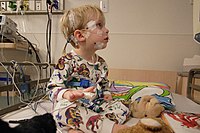
Photo from wikipedia
Purpose of review Recent advances in diagnostic testing for obstructive sleep apnea in children have refined the standard tests while identifying several new tools that hold promise to radically change… Click to show full abstract
Purpose of review Recent advances in diagnostic testing for obstructive sleep apnea in children have refined the standard tests while identifying several new tools that hold promise to radically change how we diagnose sleep apnea. Recent findings Studies have demonstrated that the polysomnogram may be modified to permit home assessment of sleep disturbed breathing in children to ensure more widespread access to the test. Alternately, questionnaires, nocturnal oximetry, and diagnostic urinary biomarkers have shown great promise as both sensitive and specific tools to diagnose sleep apnea in children as well as track the severity of the disease. Summary The gold standard polysomnogram has been refined to permit its application in a modified form at home and for brief examinations in children. This standard has been challenged on several fronts, including questionnaires, nocturnal oximetry, drug-induced sleep endoscopy, and noninvasive urinary biomarkers that may ultimately supplant polysomnography as the gold standard to diagnose obstructive sleep apnea syndrome in children.
Journal Title: Current Opinion in Anaesthesiology
Year Published: 2017
Link to full text (if available)
Share on Social Media: Sign Up to like & get
recommendations!